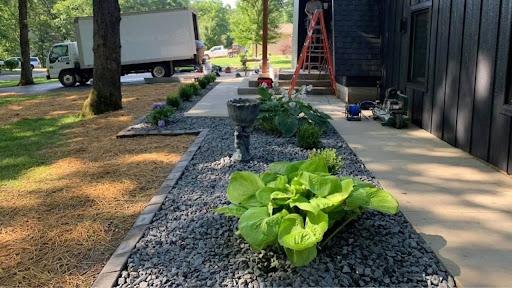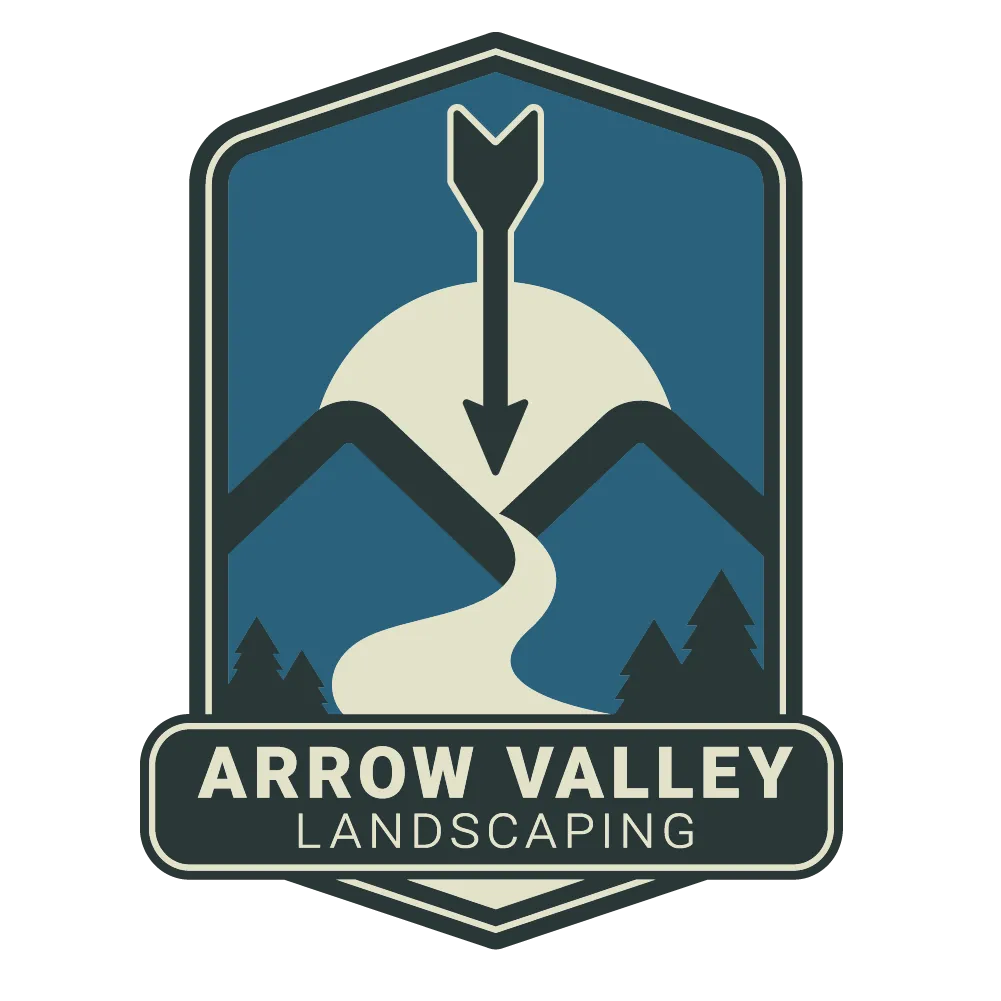Blogs

What Are Some Plants Commonly Used In Landscaping?
Common plants used in landscaping include shrubs like boxwood and hydrangeas, flowering plants such as roses and lavender, ornamental grasses like fountain grass, trees like maple and dogwood, and groundcovers such as creeping thyme and sedum.
Landscaping is more than just arranging plants—it's about creating a harmonious environment that complements your property while meeting your aesthetic and functional needs. Selecting the right plants is crucial to achieving this goal, as each type contributes uniquely to the landscape's overall beauty, diversity, and resilience.
From towering trees to delicate ground covers, the choice of plants can transform any outdoor space into a lush, inviting sanctuary. At Arrow Valley Landscaping, we believe in using a diverse range of plants that suit the local climate and enhance your property's appeal.
Key Takeaways
Trees, shrubs, ground covers, vines, perennials, and annuals are the primary categories of plants used in landscaping.
Each plant type offers unique benefits, from providing shade to adding vibrant color and texture.
Choosing the right plants for your landscape depends on factors like climate, soil type, and maintenance requirements.
Common Plants Used in Landscaping
1. Trees
Trees are the backbone of any landscape, providing structure, shade, and height to your outdoor space. They can also create privacy, reduce noise, and enhance property value. Depending on their type, trees can offer vibrant seasonal colors, flowers, or evergreen foliage for year-round interest. Selecting the right trees for your landscape involves considering their mature size, growth rate, water needs, and compatibility with local climate conditions. Whether you want a majestic oak for shade or a colorful dogwood for ornamental value, trees play a crucial role in any garden design.
Deciduous Trees:
Maple: Vibrant fall colors.
Oak: Provides significant shade and has a long lifespan.
Dogwood: Offers ornamental flowers in spring.
Evergreen Trees:
Juniper: Hardy and drought-resistant.
Spruce: Year-round greenery and easy to shape.
2. Shrubs
Shrubs are versatile plants that provide structure and fullness to a landscape. They are often used as foundation plantings, privacy screens, or to add layers of greenery. Shrubs can be either deciduous, losing their leaves in winter, or evergreen, providing color and coverage throughout the year. With a variety of shapes, sizes, and colors, shrubs can create focal points, borders, or background greenery in any landscape. Choosing the right shrubs involves understanding their growth habits, light preferences, and water needs.
Deciduous Shrubs:
Forsythia: Bright yellow flowers in early spring.
Rhododendron: Large, showy flowers and evergreen foliage.
Evergreen Shrubs:
Boxwood: Dense foliage, ideal for hedges and low maintenance.
Azalea: Vibrant blooms, commonly used in group plantings.
3. Ground Covers
Ground covers are low-growing plants that spread across the soil surface, providing a carpet-like effect. They are perfect for filling in gaps, controlling erosion, and adding texture to your landscape. These plants are usually hardy and low maintenance, making them ideal for covering large areas or adding greenery to difficult-to-maintain spots. Ground covers can thrive in various conditions, from full sun to deep shade, and can even tolerate foot traffic depending on the species chosen.
Liriope: A tough, drought-tolerant perennial, excellent for ground cover or edging.
Creeping Thyme: Aromatic, resilient, thrives in sunny areas, and withstands foot traffic.
4. Vines
Vines are climbing plants that can add vertical interest to a landscape. They are perfect for covering fences, walls, trellises, or pergolas and can provide shade, privacy, and a burst of color. Some vines are flowering, adding aesthetic appeal, while others offer dense foliage that can shield against sun and wind. Vines are particularly useful in small gardens where horizontal space is limited. Choosing vines involves considering their growth speed, required support, and maintenance needs.
Clematis: Known for stunning flowers, great for climbing structures.
Virginia Creeper: Fast-growing, excellent coverage on walls and fences.
5. Perennials
Perennials are plants that return year after year, providing long-term beauty and structure to a landscape. They are favored for their durability, varied bloom times, and ability to add color, texture, and interest to gardens throughout different seasons. Perennials can range from ground covers to tall border plants and are available in a wide array of colors and forms. Selecting the right perennials involves considering factors like soil type, sun exposure, and plant hardiness.
Hosta: Thrives in shade, available in various leaf colors and sizes.
Dianthus: Fragrant flowers in various colors, resistant to deer.
6. Annuals
Annuals complete their life cycle in one growing season, making them ideal for adding quick color and interest to any garden. They are perfect for filling gaps between perennials, brightening containers, or creating vibrant borders. While annuals need to be replanted each year, their rapid growth and striking blooms can make any landscape stand out. Choosing annuals involves thinking about bloom time, color preferences, and the specific conditions of your garden.
Marigold: Bright, cheerful flowers, easy to grow and maintain.
Petunia: Versatile, available in many colors, ideal for borders and containers.
How to Choose the Right Plants for Your Landscape
Choosing the right plants requires an understanding of your landscape's specific needs, such as climate, soil type, sunlight exposure, and water requirements. By selecting plants that are suited to your local environment, you can ensure a thriving, healthy garden. Arrow Valley Landscaping can help guide you in making the best choices.
Consider Climate: Choose plants that are well-suited to your local climate.
Assess Soil Type: Determine if your soil is sandy, clay, or loamy.
Sunlight Exposure: Understand the amount of sun your landscape receives.
Water Requirements: Select plants that match your watering capabilities.
Purpose: Decide if plants are for shade, privacy, or attracting wildlife.
The Importance of Native Plants in Landscaping
Native plants are ideal for sustainable landscaping as they are adapted to the local environment, require less maintenance, and support local wildlife. Incorporating native plants can enhance your landscape's beauty and contribute to ecological health. Arrow Valley Landscaping integrates native plants for a resilient and vibrant landscape.
Less Water Required: Native plants typically need less watering.
Low Maintenance: Reduced need for fertilizers and pesticides.
Supports Local Wildlife: Provides habitat and food for birds, bees, and butterflies.
Resilience: Adapted to local pests, weather, and soil conditions.
Environmental Contribution: Helps in maintaining biodiversity and reducing pollution.
Low-Maintenance Plants for a Hassle-Free Landscape
Low-maintenance plants are perfect for those who want a beautiful garden without much effort. These plants require minimal watering, pruning, and fertilization, making them ideal for busy homeowners. Arrow Valley Landscaping can design a low-maintenance garden tailored to your lifestyle, ensuring an attractive and manageable outdoor space.
Evergreens: Year-round greenery with minimal upkeep.
Drought-Resistant Perennials: Requires less watering and thrives in dry conditions.
Ground Covers: Prevents weeds and reduces the need for mulching.
Native Plants: Naturally adapted to the local environment, requiring less care.
Ornamental Grasses: Low water needs and adds texture to gardens.
The Role of Seasonal Plants in Landscape Design
Seasonal plants add dynamic changes to your landscape throughout the year, ensuring continuous interest and beauty. By selecting plants that bloom at different times, your garden stays vibrant year-round. Arrow Valley Landscaping helps you create a landscape that is visually appealing in every season.
Spring Bloomers: Tulips, daffodils, and forsythia for early color.
Summer Perennials: Daylilies, coneflowers, and lavender for summer beauty.
Fall Foliage: Maple, oak, and burning bush for vibrant autumn colors.
Winter Interest: Evergreen trees, holly, and ornamental grasses.
All-Season Plants: Plants like hellebores and witch hazel that thrive across multiple seasons.
Designing a Landscape for Privacy Using Plants
Creating privacy in your landscape can be achieved with strategic plant placements. Using a combination of trees, shrubs, and vines, you can form natural screens that provide both seclusion and aesthetic appeal. Arrow Valley Landscaping specializes in designing private outdoor havens for relaxation and enjoyment.
Tall Trees: Evergreens like arborvitae and leyland cypress for year-round privacy.
Dense Shrubs: Boxwood, privet, and holly to create dense hedges.
Climbing Vines: Clematis, ivy, and wisteria for covering fences and pergolas.
Layering Plants: Combine different heights for a natural, layered look.
Living Walls: Use vertical gardens or trellises for space-efficient privacy.
Frequently Asked Questions About Landscaping
What are the four kinds of plantings used in landscaping?
Trees, shrubs, ground covers, and vines.Which type of plant form should be used the most in a landscape?
Trees, as they provide structure, shade, and focal points in a landscape.What is landscaping planting?
The process of strategically placing plants to enhance the aesthetic and functional aspects of an outdoor space.Why are plants important in landscaping?
Plants provide beauty, shade, privacy, and support local ecosystems by attracting wildlife.What are the 3 major landscape types?
Hardscape, softscape, and waterscape.
Transform Your Landscape with Arrow Valley Landscaping
Choosing the right plants is an art that can elevate your outdoor space to new heights. At Arrow Valley Landscaping, we take pride in transforming ordinary yards into extraordinary landscapes that flourish year-round.
Our team of experts understands the unique challenges and opportunities of local climate and soil, ensuring your plants not only survive but thrive. With a thoughtfully curated selection of trees, shrubs, perennials, and annuals, we craft beautiful, functional spaces that delight the senses and bring your vision to life.
Contact us today to schedule a consultation and begin your journey toward a greener, more beautiful outdoor space!

With years of experience serving Illinois, we’re proud to be the trusted choice for a professional and high quality landscaping.
Contact Us
Phone:
Email:
Address
© 2025 Arrow Valley Landscape ltd. All Rights Reserved. Privacy Policy. Web Design by Fused Media



